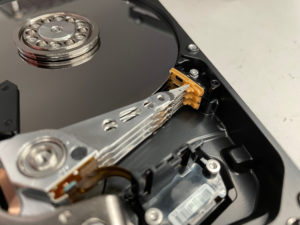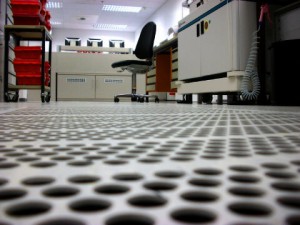
The read/write heads of a hard drive in a resting position.
Stuck heads occur when a hard drive’s read/write heads are locked into place on (or over) the hard drive’s platters. They’re unable to move back to their original position, and the hard drive’s spindle may be unable to rotate the platters.
Depending on the model, stuck heads may be easy to address in a professional data recovery laboratory — but they cannot be safely fixed without appropriate equipment.
If you notice any signs of physical hard drive damage, keep your drive powered off. Operating the drive may cause platter scoring, which causes permanent data loss.
Below, we’ll explore common symptoms of stuck heads and explain why they occur. Datarecovery.com provides risk-free media evaluations, and we support our services with a no data, no charge guarantee: If we’re unable to restore your data, you don’t pay for the attempt.
Call 1-800-237-4200 to speak with an expert or submit a case online.
Common Symptoms of Stuck Heads on a Hard Drive
Stuck heads may cause the drive to appear totally dead: The platters don’t move, and the drive isn’t recognized by the operating system.
However, on most models, the drive will continue to attempt normal operation, which leads to the classic signs of a head crash:
- Beeping sounds.
- A repetitive “whining” sound, caused by the actuator assembly attempting to return to its resting position.
- Grinding, clicking, or other unusual noises.
These are serious symptoms. In normal operation, the read/write heads float a small distance from the surface of the platters, supported by a cushion of air.
If the hard drive’s heads are in direct contact with the platters, scoring can occur quickly, permanently destroying your data.
Related: Please Don’t Pry Open Your Hard Drive (Unless You Don’t Need the Data)
What causes a hard drive’s read/write heads to become stuck in place?
Stuck heads frequently occur after an impact. If you’ve dropped your hard drive and it no longer operates, you’ve likely experienced some type of head crash, but the drive will need to be evaluated to determine the extent of the damage.
Occasionally, heads may become stuck during normal operation (with no impact damage, electronic damage, or other obvious reasons for the failure). On average, hard drives operate for 3-5 years, but any hard drive can fail at any time — a good reason to keep an up-to-date backup of important files.
Related: Do Most Hard Drives Fail Before the 3-Year Mark?
Can I do anything to fix stuck heads on a hard drive?
No. When a head crash occurs on a modern hard drive, the device needs to be treated in a certified cleanroom to prevent platter contamination.

The floor of a data recovery clean room.
Decades ago, this wasn’t necessarily true: Hard drives from the 1990s could sometimes be recovered (at least temporarily) with the infamous “freezer trick,” or with other non-conventional methods.
But modern drives have extremely high areal densities, and they’re not simple devices: Many have firmware (operating instructions) that are specific to the individual drive. Even if you could “unstick” the heads from the platters, the hard drive would likely have issues reading and writing data.
If you have a recent backup, the best course of action is to replace the damaged hard drive. Otherwise, you’ll need professional data recovery services.
Here’s the good news: While stuck heads are a severe problem, the chances of a successful recovery are quite high.
However, every time you turn on the drive, you risk additional platter damage. We strongly recommend turning the hard drive off as soon as you notice signs of physical failure. Keep the drive powered off.
Choosing a Hard Drive Data Recovery Provider
To treat stuck heads, data recovery engineers will open the hard drive in a certified cleanroom, replace the damaged components, and create a complete clone of the device. At that point, they can address any file corruption or other logical issues that occurred following the failure.
When choosing a provider, keep these tips in mind:
- Avoid data recovery companies that charge a flat fee per attempt. Learn about the problem with flat-rate hard drive data recovery.
- Make sure the provider has actual laboratories at each location. Datarecovery.com does not operate “mailing room” offices — each of our locations is fully outfitted with certified cleanrooms and other essential data recovery equipment.
- Ask for references and research the company online. Read reviews from Datarecovery.com customers.
- Determine whether you’ll pay if the recovery is unsuccessful. Our no data, no charge guarantee is based on the data you identify as important: If we don’t get the files you need, there’s no charge for the attempt.
If you’ve lost data due to a hard drive failure, we’re here to help. Call 1-800-237-4200 or schedule a risk-free evaluation online.




